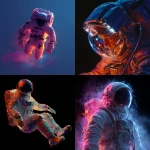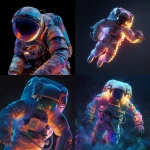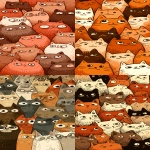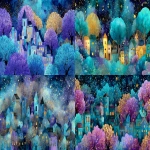Explore the Best AI Image Gallery

Beyond the Brushstroke: How Edge Computing is Empowering Creative Expression
The convergence of creativity and technology has always been a captivating narrative. But with the rise of edge computing, this story takes an exciting turn, blurring the lines between the physical and digital realms and empowering artists and designers in unprecedented ways.
A New Frontier for Artistic Expression
Edge computing, which processes data closer to its source rather than relying on centralized cloud servers, brings several advantages to the creative industry:
- Real-time Collaboration: Imagine artists from different locations seamlessly collaborating on a digital canvas, with changes reflected instantaneously. Edge computing enables this by minimizing latency and facilitating real-time interaction between participants.
- Immersive Experiences: Edge computing fuels the creation of truly immersive artistic experiences. From interactive installations that respond to user movements to virtual reality (VR) environments where art comes alive, the possibilities are limitless.
- Personalized Creativity: Edge-powered applications can analyze user preferences and generate personalized creative outputs. Think AI-driven tools that assist in composing music, designing patterns, or even sculpting 3D models based on individual tastes.
Case Studies: Where Edge Computing Meets Creativity
Several compelling examples demonstrate the transformative impact of edge computing on creative endeavors:
- Interactive Art Installations: Artists are utilizing edge-powered sensors and displays to create installations that respond to audience interaction. Movements, sounds, or even emotions can trigger dynamic changes in the artwork, blurring the line between observer and participant.
- VR/AR Art Experiences: Edge computing enhances VR and AR art experiences by reducing latency and enabling real-time interactions within virtual worlds. Users can explore 3D sculptures, interact with digital paintings, or even participate in collaborative art projects within these immersive environments.
- Personalized Music Composition: AI-powered tools leveraging edge computing can analyze user preferences and generate personalized music pieces based on mood, genre, or even specific instruments. This opens up new avenues for musicians to explore and express themselves creatively.
Ethical Considerations: Navigating the Complexities
As with any powerful technology, edge computing in the creative industry raises important ethical considerations:
- Data Privacy and Security: Edge devices often collect user data, raising concerns about privacy and security. Its crucial to ensure that data is handled responsibly, with transparent policies and robust security measures in place.
- Algorithmic Bias: AI algorithms used in edge-powered creative tools can inherit biases from the data they are trained on. This can result in discriminatory or unfair outputs, requiring careful attention to mitigate bias throughout the development process.
- Accessibility and Inclusion: Its essential to ensure that edge computing technologies are accessible to all individuals, regardless of their technical expertise or disabilities. Inclusive design principles should be incorporated to create equitable opportunities for creative expression.
Future Trends: The Horizon of Creative Possibilities
The future of edge computing in the creative industry is brimming with exciting possibilities:
- Seamless Integration with Physical Environments: Edge-powered sensors and actuators will increasingly blend the digital and physical realms, enabling interactive installations that respond to their surroundings in real time.
- Decentralized Creative Platforms: Edge computing could foster decentralized creative platforms where artists can collaborate, share their work, and monetize their creations directly, bypassing traditional intermediaries.
- Hyper-Personalized Creative Experiences: Edge-powered AI will continue to refine its ability to personalize creative outputs, tailoring artistic experiences to individual preferences and fostering a sense of ownership and connection with the art itself.
Edge computing is poised to revolutionize the creative landscape, empowering artists, designers, and innovators with unprecedented tools for expression and collaboration. By embracing its potential while navigating its ethical complexities, we can unlock a future where creativity knows no bounds.

](https://images.ai-img.art/thumbnails/150/4f3d83c4b1d979b5be00f4ea80d67b71c0335bc1163e692d738e553ac37709e5.webp)
![**ultra detailed 8k cinematic black and white beauty portrait of a young woman from chest up, vertical frame, face, hands and hair filling the composition, smooth neutral grey studio background with soft dark vignette on the edges, center of the frame is her eye, lips and finger in a "shh" gesture oval symmetrical face with soft but well defined features, ultra smooth flawless skin, no pores, no wrinkles, perfect beauty retouch, straight elegant nose with soft highlight along the bridge and gentle shadow under the tip full sensuous lips with a sharp cupid’s bow, slightly parted, a thin bright glossy highlight strip on the lower lip emphasizing volume, subtle light reflection on the lip gloss one eye visible through a gap between fingers, other eye mostly hidden by the upper hand, long thick eyelashes like fake lashes, small bright catchlight in the pupil, upper eyelid with smoky eye makeup, darker tone along lash line fading smoothly towards the brow, dark thick well shaped eyebrows, gently arched, not overdramatic dark wavy hair, big glossy waves falling down, one clear S-shaped wave on the right side of the frame, soft highlights along the strands to show texture, hair swept away from the cheeks so the face is not covered both hands in thin semi-transparent black gloves up to the forearm, upper hand placed horizontally across the upper face, back of the hand towards camera, fingers slightly spread so that one finger is above the brows and another lower finger creates a narrow gap that reveals the eye, fingertips long and tapered, sharp stiletto-like nails visible under the sheer fabric, subtle darker seams along the fingers and glove edges lower hand bent so that the index finger is vertical and gently touching the center of the lips in a classic "shhh" pose, [...]** - Image #4 <@1264899319799222315>](https://images.ai-img.art/thumbnails/150/8507c113aa12343ebd50af4ab9c637a6cf1acf21c55772271eb6a66bb04fa39c.webp)





](https://images.ai-img.art/thumbnails/150/1871c145bfe0276c6e1bacf6ec0da6d2dae71370bf71674589af29a201acdd5f.webp)

](https://images.ai-img.art/thumbnails/150/5487dcbcab0cd5702a67cc6819342ef56c05d0fc7730bfb7718ee291f10c3da3.webp)
](https://images.ai-img.art/thumbnails/150/e07ad2e7379a835127482b0fd3176192c001c90e68a85b4315cf482b6a3f5ea5.webp)









![**ultra detailed 8k cinematic black and white beauty portrait of a young woman from chest up, vertical frame, face, hands and hair filling the composition, smooth neutral grey studio background with soft dark vignette on the edges, center of the frame is her eye, lips and finger in a "shh" gesture oval symmetrical face with soft but well defined features, ultra smooth flawless skin, no pores, no wrinkles, perfect beauty retouch, straight elegant nose with soft highlight along the bridge and gentle shadow under the tip full sensuous lips with a sharp cupid’s bow, slightly parted, a thin bright glossy highlight strip on the lower lip emphasizing volume, subtle light reflection on the lip gloss one eye visible through a gap between fingers, other eye mostly hidden by the upper hand, long thick eyelashes like fake lashes, small bright catchlight in the pupil, upper eyelid with smoky eye makeup, darker tone along lash line fading smoothly towards the brow, dark thick well shaped eyebrows, gently arched, not overdramatic dark wavy hair, big glossy waves falling down, one clear S-shaped wave on the right side of the frame, soft highlights along the strands to show texture, hair swept away from the cheeks so the face is not covered both hands in thin semi-transparent black gloves up to the forearm, upper hand placed horizontally across the upper face, back of the hand towards camera, fingers slightly spread so that one finger is above the brows and another lower finger creates a narrow gap that reveals the eye, fingertips long and tapered, sharp stiletto-like nails visible under the sheer fabric, subtle darker seams along the fingers and glove edges lower hand bent so that the index finger is vertical and gently touching the center of the lips in a classic "shhh" pose, [...]** - Image #1 <@1264899319799222315>](https://images.ai-img.art/thumbnails/150/ff5a24c7c060f5350508823c406c28c9596aea4e37eefb60abc0f37504a37383.webp)







](https://images.ai-img.art/thumbnails/150/7c4350a99935771fe343a7ae65c780cf4cd6b861e69cdc32bd58a3a92fb2476f.webp)



![**ultra detailed 8k cinematic black and white beauty portrait of a young woman from chest up, vertical frame, face, hands and hair filling the composition, smooth neutral grey studio background with soft dark vignette on the edges, center of the frame is her eye, lips and finger in a "shh" gesture oval symmetrical face with soft but well defined features, ultra smooth flawless skin, no pores, no wrinkles, perfect beauty retouch, straight elegant nose with soft highlight along the bridge and gentle shadow under the tip full sensuous lips with a sharp cupid’s bow, slightly parted, a thin bright glossy highlight strip on the lower lip emphasizing volume, subtle light reflection on the lip gloss one eye visible through a gap between fingers, other eye mostly hidden by the upper hand, long thick eyelashes like fake lashes, small bright catchlight in the pupil, upper eyelid with smoky eye makeup, darker tone along lash line fading smoothly towards the brow, dark thick well shaped eyebrows, gently arched, not overdramatic dark wavy hair, big glossy waves falling down, one clear S-shaped wave on the right side of the frame, soft highlights along the strands to show texture, hair swept away from the cheeks so the face is not covered both hands in thin semi-transparent black gloves up to the forearm, upper hand placed horizontally across the upper face, back of the hand towards camera, fingers slightly spread so that one finger is above the brows and another lower finger creates a narrow gap that reveals the eye, fingertips long and tapered, sharp stiletto-like nails visible under the sheer fabric, subtle darker seams along the fingers and glove edges lower hand bent so that the index finger is vertical and gently touching the center of the lips in a classic "shhh" pose, [...]** - Image #2 <@1264899319799222315>](https://images.ai-img.art/thumbnails/150/d87499f6bdc5a4a822aea4674654f70073b052542a1aaa1d08461a13ca2e07f9.webp)


](https://images.ai-img.art/thumbnails/150/d08f607caf4a5c380defef68b778febb8911e8e51e51927b09ed67880bd3084b.webp)



](https://images.ai-img.art/thumbnails/150/f3411154f4c743a26f102ecfc985f3f6214e93b285748fac66c88f3b52f85b26.webp)






![**ultra detailed 8k cinematic black and white beauty portrait of a young woman from chest up, vertical frame, face, hands and hair filling the composition, smooth neutral grey studio background with soft dark vignette on the edges, center of the frame is her eye, lips and finger in a "shh" gesture oval symmetrical face with soft but well defined features, ultra smooth flawless skin, no pores, no wrinkles, perfect beauty retouch, straight elegant nose with soft highlight along the bridge and gentle shadow under the tip full sensuous lips with a sharp cupid’s bow, slightly parted, a thin bright glossy highlight strip on the lower lip emphasizing volume, subtle light reflection on the lip gloss one eye visible through a gap between fingers, other eye mostly hidden by the upper hand, long thick eyelashes like fake lashes, small bright catchlight in the pupil, upper eyelid with smoky eye makeup, darker tone along lash line fading smoothly towards the brow, dark thick well shaped eyebrows, gently arched, not overdramatic dark wavy hair, big glossy waves falling down, one clear S-shaped wave on the right side of the frame, soft highlights along the strands to show texture, hair swept away from the cheeks so the face is not covered both hands in thin semi-transparent black gloves up to the forearm, upper hand placed horizontally across the upper face, back of the hand towards camera, fingers slightly spread so that one finger is above the brows and another lower finger creates a narrow gap that reveals the eye, fingertips long and tapered, sharp stiletto-like nails visible under the sheer fabric, subtle darker seams along the fingers and glove edges lower hand bent so that the index finger is vertical and gently touching the center of the lips in a classic "shhh" pose, [...]** - Image #3 <@1264899319799222315>](https://images.ai-img.art/thumbnails/150/4c03a422708b372b43caaee1e2929933c40f0a13dc069beeeb228a60b126223b.webp)

